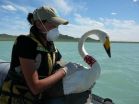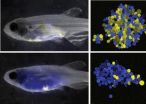(Press-News.org) A group of international scientists have completed the first global inventory of flu strains in birds by reviewing more than 50 published studies and genetic data, providing new insight into the drivers of viral diversity and the emergence of disease that can ultimately impact human health and livelihoods.
The research, published in the journal PLOS ONE and performed as part of the USAID PREDICT project, identified over 116 avian flu strains in wild birds. This is roughly twice the number that were found in domestic birds, and more than ten times the number found in humans. Additionally, an analysis of studies that sampled more than 5,000 birds suggested some regions may have more viral diversity than others.
Avian flu outbreaks come with no warning. In 2013, an H7N9 avian flu strain caused a deadly outbreak in people in China. This surprised virologists, as the strain had never before caused disease in humans. To date, there have been more than 300 clinical cases of H7N9 with a 33 percent mortality rate. This year, another strain known to infect birds, H10N8, has caused human cases for the first time.
As was the case in the H7N9 outbreak, most direct bird-to-human spillover events (when a virus jumps from one species to another) of avian flu can be traced back to human contact with domestic poultry. Although avian flu strain diversity often originates in wild birds, it is the mixing of viruses among poultry, pigs, and people that substantially heightens the disease risk in humans.
In an effort to improve preparedness, scientists are looking to better understand and monitor the diversity of all avian flu viruses – not just those known to cause disease. Completing the first global inventory of flu strains in birds is a key step in building that understanding.
"This snapshot of the world of flu virus diversity in birds is the outcome of many years of ecology and evolution, as viewed through the lens of surveillance methods utilized by scientists from around the world," said study lead and Wildlife Conservation Society (WCS) Associate Director of Wildlife Epidemiology, Dr. Sarah Olson.
Understanding the natural diversity of viruses is critically important to identifying health risks. But authorities face a challenge, both in focusing efforts in the right places, and adequately financing surveillance to describe global flu diversity. To address this, the authors introduced a new method, which borrows on approaches used by ecologists, to estimate the diversity of flu viruses in a particular location. With this approach, health authorities can design surveillance programs to detect a given percentage of flu virus diversity.
The scientists also looked at patterns of flu diversity in different bird hosts. Mallards carry the highest number of strains at 89 and ruddy turnstones were second with 45. The more a strain was shared across wild bird types, the more likely it was to be found in domestic birds, a risk factor for spillover events. They also noted that some strains could be specific to certain bird types. For example, gulls and shorebirds (Charadriiformes) carried ten strains that have not been identified in any other bird order.
According to Dr. Olson, "This inventory isn't about blaming wild birds, but it allows us to map what we know, and informs our understanding of what drives viral diversity and the emergence of rare viral strains that can infect people. Given that flu viruses can jump from domestic poultry to people, ongoing efforts at improving biosecurity at poultry farms and markets remain key to outbreak prevention."
INFORMATION:
The co-authors of the study, "Sampling strategies and biodiversity of influenza A subtypes in wild birds," include: Sarah Olson and Martin Gilbert of the Wildlife Conservation Society; Jane Parmley and Frederick Leighton of the Canadian Cooperative Wildlife Health Center; Catherine Soos of Environment Canada; Neus Latorre-Margalef of the EEMiS, Linnaeus University; Jeffrey Hall of the USGS National Wildlife Health Center; Philip Hansbro of the University of Newcastle; Vincent Munster of the National Institutes of Health; and Damien Joly of Metabiota.
The study can be found at http://dx.plos.org/10.1371/journal.pone.0090826.
Birds of all feathers and global flu diversity
2014-03-06
ELSE PRESS RELEASES FROM THIS DATE:
Returning vets face 'warring identities' distress
2014-03-06
PROVIDENCE, R.I. [Brown University] — Much of the research on post-combat mental health of veterans focuses on problems like post-traumatic stress disorder (PTSD) and major depression. A paper co-authored by R. Tyson Smith, visiting assistant professor of sociology, takes an even broader snapshot of returning soldiers' mental state by focusing instead on the identity conflict many face when transitioning from soldier to civilian life and how that conflict manifests as mental distress. The paper was published in the January issue of Society and Mental Health.
"You can't ...
Colored diamonds are a superconductor's best friend
2014-03-06
Flawed but colorful diamonds are among the most sensitive detectors of magnetic fields known today, allowing physicists to explore the minuscule magnetic fields in metals, exotic materials and even human tissue.
University of California, Berkeley, physicist Dmitry Budker and his colleagues at Ben-Gurion University of the Negev in Israel and UCLA have now shown that these diamond sensors can measure the tiny magnetic fields in high-temperature superconductors, providing a new tool to probe these much ballyhooed but poorly understood materials.
"Diamond sensors will give ...
Alzheimer's research team employs stem cells to understand disease processes and study new treatment
2014-03-06
Boston, MA – A team of Alzheimer's disease (AD) researchers at Brigham and Women's Hospital (BWH) has been able to study the underlying causes of AD and develop assays to test newer approaches to treatment by using stem cells derived from related family members with a genetic predisposition to (AD).
"In the past, research of human cells impacted by AD has been largely limited to postmortem tissue samples from patients who have already succumbed to the disease," said Dr. Tracy L. Young-Pearse, corresponding author of the study recently published in Human Molecular Genetics ...
E-cigarettes: Gateway to nicotine addiction for US teens, says UCSF study
2014-03-06
E-cigarettes, promoted as a way to quit regular cigarettes, may actually be a new route to conventional smoking and nicotine addiction for teenagers, according to a new UC San Francisco study.
In the first analysis of the relationship between e-cigarette use and smoking among adolescents in the United States, UCSF researchers found that adolescents who used the devices were more likely to smoke cigarettes and less likely to quit smoking. The study of nearly 40,000 youth around the country also found that e-cigarette use among middle and high school students doubled between ...
Up-converted radio
2014-03-06
Ever worry about losing your mobile-phone reception? The problem is a weak microwave signal. The same problem hampers cosmologists looking at the early universe, a glimpse embodied in the cosmic microwave background. Or take a pressing earthly example: oncologists often locate and identify tumors using MRI scans. All three of these efforts---communications, cosmology, medicine---depend on discriminating weak microwave or radio signals from a noisy environment. A new approach to this important problem provides a clean, all-optical detection of microwaves and radiowaves ...
Discovery sheds new light on marijuana's anxiety relief effects
2014-03-06
An international group led by Vanderbilt University researchers has found cannabinoid receptors, through which marijuana exerts its effects, in a key emotional hub in the brain involved in regulating anxiety and the flight-or-fight response.
This is the first time cannabinoid receptors have been identified in the central nucleus of the amygdala in a mouse model, they report in the current issue of the journal Neuron.
The discovery may help explain why marijuana users say they take the drug mainly to reduce anxiety, said Sachin Patel, M.D., Ph.D., the paper's senior ...
Some people really just don't like music
2014-03-06
It is often said that music is a universal language. However, a new report in the Cell Press journal Current Biology on March 6 finds that music doesn't speak to everyone. There are people who are perfectly able to experience pleasure in other ways who simply don't get music in the way the rest of us do.
The researchers refer to this newly described condition as specific musical anhedonia—in other words, the specific inability to experience pleasure from music.
"The identification of these individuals could be very important to understanding the neural basis of music—that ...
'Seeing' bodies with sound (no sight required)
2014-03-06
People born unable to see are readily capable of learning to perceive the shape of the human body through soundscapes that translate images into sound, according to researchers who report their findings in the Cell Press journal Current Biology on March 6. With a little training, soundscapes representing the outlines and silhouettes of bodies cause the brain's visual cortex—and specifically an area dedicated in normally sighted people to processing body shapes—to light up with activity.
With no more than 70 hours of training on average, study participants could recognize ...
Common mutation is culprit in acute leukemia relapse
2014-03-06
Harvard stem cell scientists have identified a mutation in human cases of acute lymphoblastic leukemia that likely drives relapse. The research, published in Cancer Cell, could translate into improved patient care strategies for this particular blood cancer, which typically affects children but is more deadly in adults.
In recent years, a trend toward single-cell analysis has shown that individual cells within a tumor are capable of amassing mutations to make them more aggressive and treatment resistant. So while 99% of a tumor may be destroyed by the initial treatment, ...
Warming temperatures are pushing 2 chickadee species -- and their hybrids -- northward
2014-03-06
The zone of overlap between two popular, closely related backyard birds is moving northward at a rate that matches warming winter temperatures, according to a study by researchers from the Cornell Lab of Ornithology, Villanova University, and Cornell University. The research will be published online in Current Biology on Thursday, March 6, 2014.
In a narrow strip that runs across the eastern U.S., Carolina Chickadees from the south meet and interbreed with Black-capped Chickadees from the north. The new study finds that this hybrid zone has moved northward at a rate ...




